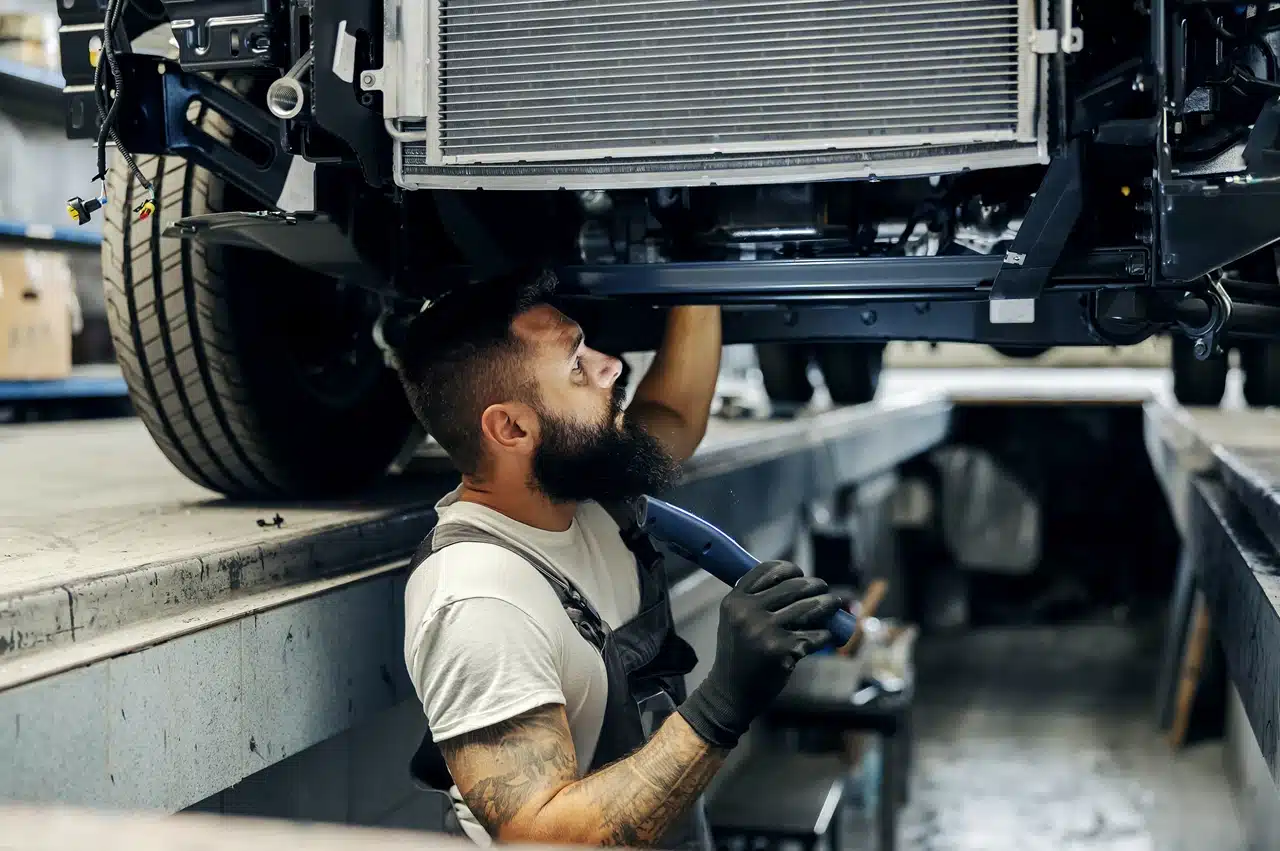A heart attack victim’s chance of survival depends on how quickly help arrives:
- Within 4 minutes: 50% survival rate.
- At 8 minutes: 25% survival rate.
- At 12 minutes: less than 10% survival rate.
You might assume traffic delays are the main problem. But the real threat sits unnoticed in firehouse garages.
Every minute without CPR and an AED drops survival rates by 10%. Despite clear roads, emergency response times are getting worse. First responders arrive at critical scenes, only to discover their backup vehicle won’t start. Dispatchers realize mid-crisis that their “available” ambulance is broken down.
Equipment failures caused by poor maintenance sabotage rescue missions daily. This hidden crisis quietly weakens emergency response nationwide.
The solution isn’t faster sirens or fewer traffic lights—it’s reliable emergency vehicles. Smart fleet management systems prevent breakdowns before they occur, ensuring vehicles are ready when every second counts.
This article uncovers the overlooked fleet management crisis harming emergency response, highlighting technology solutions departments use to stop breakdowns before lives are lost.
The Real Cost of Fleet Failures in Emergency Response
While everyone focuses on traffic congestion and driver training, the elephant in the emergency services garage is equipment reliability. The scope of this hidden problem is staggering:
- Equipment Downtime Crisis: Well-trained drivers can find 30% of problems before they become costly repairs or cause breakdowns, yet most departments still experience significant unplanned vehicle failures
- Critical System Failures: Emergency vehicles face unique stress patterns—sitting idle for hours, then sudden extreme stress during calls—that standard maintenance schedules can’t handle
- Coverage Gap Reality: When primary vehicles break down and backup equipment isn’t properly maintained, cascade failures create dangerous coverage gaps across entire service areas
The consequences extend far beyond individual incidents. Picture a cardiac arrest where the responding ambulance battery dies on scene, or a structure fire where the ladder truck’s hydraulics fail while firefighters are inside the building. These aren’t theoretical scenarios—they’re happening in departments nationwide.
The Financial Burden:
- Emergency vehicle costs range from $200,000 for ambulances to over $1 million for specialized apparatus
- Unplanned downtime forces overtime payments for crews stranded without working vehicles
- Total cost of all emergency vehicle crashes in the U.S. is estimated at $35 billion annually • Emergency replacement costs devastate budgets already stretched thin
Perhaps most critically, public trust erodes when response failures make local news. Communities expect their emergency services to be ready when called, and equipment-related delays raise uncomfortable questions about department preparedness.
Why Traditional Fleet Management Isn’t Working for Emergency Response
The fundamental problem isn’t that emergency departments don’t maintain their vehicles—it’s that they’re using maintenance approaches designed for normal vehicles operating under normal conditions.
The Reactive Maintenance Trap:
- Most departments still use calendar-based maintenance schedules that ignore actual vehicle stress patterns
- No predictive insights into critical system health before failures occur • NFPA 1911 standards require operational checks within 24 hours of runs or weekly, but many departments struggle with consistent compliance
- Critical systems failing without warning during life-or-death situations
Dangerous Visibility Gaps:
- Dispatch centers routinely assume vehicles are deployment-ready when they’re not
- No real-time monitoring of engine diagnostics, battery status, or hydraulic systems
- Equipment readiness determined by visual inspection rather than data-driven analysis
- Problems develop silently until they cause failures during emergencies
The Emergency Services Paradox:
The median ambulance response time for cardiac arrest has doubled from 5-6 minutes in the early 1990s to 11 minutes in 2017, and equipment reliability plays a significant role in this decline. Emergency vehicles face:
- Extreme stop-and-start patterns with sudden high-stress periods
- Exposure to harsh conditions including salt, heat, and constant idling
- Budget constraints forcing departments to stretch vehicle lifecycles beyond reasonable limits • Technology gaps that would be unacceptable in other life-safety industries
What a Smarter Approach Looks Like
Modern emergency fleet management represents a complete shift from reactive maintenance to predictive protection. Instead of waiting for equipment to fail, intelligent systems identify problems days or weeks before they become critical failures.
- Real-Time Vehicle Health Monitoring Advanced diagnostics monitor engine performance, battery status, hydraulic pressure, and other critical systems continuously. When a fire truck’s pump pressure drops below optimal levels or an ambulance battery shows signs of failure, maintenance teams receive immediate alerts before these systems are needed during emergencies.
- True Availability Intelligence Integration with dispatch systems provides real-time vehicle status that goes beyond “parked in the station.” Dispatchers can see which vehicles are truly deployment-ready versus those with developing mechanical issues. Historical data predicts when equipment needs service, allowing maintenance scheduling during low-activity periods.
- Emergency-Ready Maintenance Usage-based maintenance accounts for unique emergency vehicle demands including sudden acceleration, emergency braking, and equipment operating under extreme stress. Automated compliance tracking ensures critical safety systems meet NFPA requirements, while vendor coordination minimizes downtime during necessary service.
- Performance Optimization Route analysis factors in vehicle capabilities and current health status, ensuring the most reliable equipment responds to highest-priority calls. Driver behavior monitoring helps extend vehicle lifecycles by identifying practices causing unnecessary wear, while budget forecasting prevents emergency replacement scenarios.
For example, a metropolitan fire department seemed to experience random equipment failures during emergency calls—ladder trucks with hydraulic issues, engines with pump problems, ambulances with dead batteries.
The pattern only became clear after implementing predictive fleet monitoring: these weren’t random failures, they were predictable maintenance issues occurring during high-stress emergency operations.
With early warning systems in place, they now receive alerts days before potential failures, schedule maintenance during low-activity periods, and haven’t had a single vehicle breakdown during an emergency response in over 18 months.
What’s at Stake—and What’s Possible
Emergency departments continuing to operate with reactive fleet management face escalating risks that extend far beyond maintenance costs:
The Cost of Equipment Gambling:
- Continued increase in response-time-affecting equipment failures
- First responder safety risks from unreliable life-safety equipment
- Public safety gaps when backup systems aren’t actually functional
- Emergency replacement costs that devastate department budgets
- Legal liability when equipment failures contribute to poor outcomes
The Transformation Reality: Departments implementing predictive fleet management typically achieve:
- 60-80% reduction in emergency-response equipment failures
- 15-25% improvement in true vehicle availability rates
- 40-50% decrease in unplanned maintenance costs
- Measurable improvement in consistent response capabilities
- Enhanced first responder confidence in their equipment
The financial impact extends beyond maintenance savings. With more reliable equipment, departments reduce overtime costs for crews stranded with broken vehicles, avoid emergency replacement purchases, and maintain the public trust essential for continued funding and community support.
The Bottom Line
The biggest threat to emergency response times isn’t traffic congestion, inadequate funding, or insufficient training—it’s unreliable equipment that fails when lives hang in the balance. Every equipment failure during an emergency represents a preventable tragedy risk that compounds with each incident.
Traditional fleet management approaches designed for normal vehicle operations are inadequate for the life-safety demands of emergency services. Nearly two-thirds (64%) of fire department calls require EMS services, making vehicle reliability critical for both fire suppression and medical response.
Your community calls 911 expecting help to arrive quickly and ready to perform. When emergency vehicles fail during critical moments, the consequences extend far beyond repair bills or response time statistics. The technology exists today to eliminate most emergency equipment failures, but only if departments move beyond reactive maintenance to predictive protection.
The question isn’t whether your department can afford to upgrade fleet management—it’s whether your community can afford the consequences of equipment failures during emergencies. Every day of delay increases the risk that a critical call will be met with a vehicle that won’t start, equipment that won’t function, or backup systems that aren’t actually ready to respond.
Ready to Ensure Your Equipment Is Always Ready When Lives Depend on It?
Want to see how GoFleet helps emergency response teams prevent equipment failures before they impact critical calls? Our predictive fleet management solutions have helped fire departments, EMS services, and police forces eliminate emergency vehicle breakdowns while improving overall response reliability.
Book a free demo or talk to our emergency services specialists today to learn how we can help ensure your equipment is always ready when lives depend on it.









